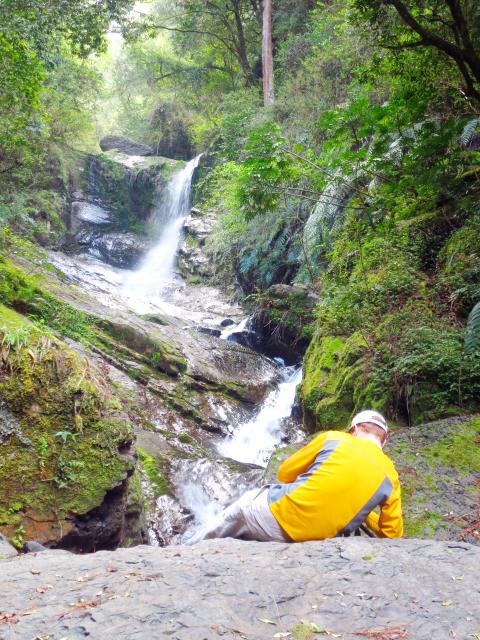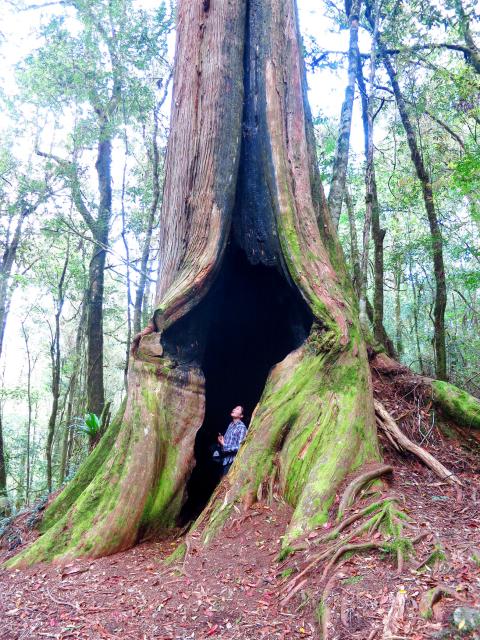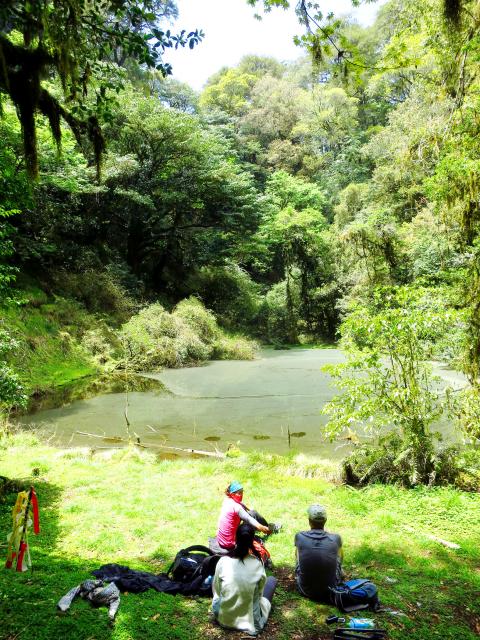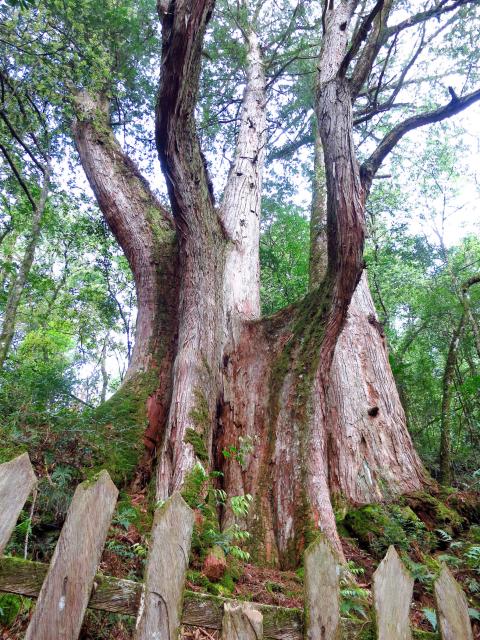There’s a rather charming idiom by which Chinese-speakers describe some of their most enchanting landscapes: renjianxianjing (人間仙境), which means “fairyland on earth.” It’s become a bit of a tourist cliche, but enchanting is definitely the word for the majestic mountain fastness of Taiwan’s wild interior, which is covered in great forests, where ancient god-like giants tower above the surrounding trees, their limbs stretching high above their competitors in search of the sun. These aren’t monsters from some fairy tale, however, but huge red cypress trees that grow to a prodigious age and vast dimensions in the cool, moist and undisturbed remoteness of the nation’s interior.
The lower temperatures and prevailing mistiness at these medium-high altitudes are perfect conditions for the cloud forests that clothe the mountains there. Here, in a wide arc stretching from the New Taipei City-Taoyuan border all the way to the slopes of Dawu Mountain (大武山) in southern Pingtung, Taiwan red cypress trees once grew to the mind-boggling age of 2,000 or even 3,000 years. Unfortunately, the Japanese saw these magnificent trees as a perfect hardwood source. Tree numbers have dwindled greatly since the colonial period, and continue to be depleted thanks to illegal logging activities of so-called “mountain rats (山老鼠).” Even today though, some of the world’s largest trees can still be found here, if you look in the right places: sheltered slopes above mountain streams at altitudes between 900m and 2,600m.
For the average visitor, the easiest ancient trees to reach are in the famous grove at Lalashan (拉拉山) in southern Taoyuan — a group of about twenty majestic trees that can be enjoyed over a long day trip from Taipei by visitors with their own transport. Next up, and possibly even more popular than Lalashan nowadays, is Smangus Village in Hsinchu County, which features the third largest tree in Taiwan, with a circumference near the base of 16m.

Photo: Richard Saunders
Rather than joining the tourists at Smagus, though, if you can spare two days a bit more effort, head instead for the quieter groves at nearby Jhensibao (鎮西堡). Just a decade ago, this place was still largely unknown to the general public, and although the overflow from Smangus is now heading here, the trails are a little longer, a little rougher and a lot steeper, which naturally keeps visitor numbers down.
The trip begins at the Atayal Aboriginal village of Singuang (新光) in a remote corner of southern Hsinchu County, from where it’s a further seven kilometers to the trailhead. With the increasing popularity of Jhensibao, this road is bound to be improved sometime soon, but as of my last visit it was still very slow going and rough. The trailhead is marked by a couple of small shacks (where snacks and drinks are sold on weekends) and a parking area.
Just after the car park, take the track that veers off to the right, and in a few minutes, it turns into a dirt trail, climbing steadily through the forest zigzagging to a clearly signposted junction (2.5km from the trailhead).

Photo: Richard Saunders
It’s decision time.
Jhensibao has two ancient tree groves. The more popular by far is Grove B, which is an easier hike (4-5 hours return) and has the largest number of impressive trees. Grove A is a much steeper walk, and apart from one huge monster, the trees aren’t quite as impressive. However, there’s a good chance you’ll meet no one on the walk up there and back, and fit hikers can scramble all the way up to the small but mysterious Dulongtan (毒龍潭), literally “Poison Dragon Pool,” allow at least six hours for the return trip if planning to go this far.
To explore Grove B simply follow the clear trail straight ahead uphill for another kilometer, until it forks again at the start of the loop trail around giant trees with names such as the King, the Queen, Adam and Eve.

Photo: Richard Saunders
For Grove A, turn right at the junction near the 2.5km mark and climb steeply, reaching the first tree after about 40 tiring minutes. From here, follow the plastic trail-marking ribbons carefully to keep to the correct route. About 15 minutes after the first giant tree is the “squashed flat” tree, which, as the name implies, is strangely deformed. To the left and behind it, a trail leads to Dulongtan, high in the hills above. It’s a steep three-hour walk from this point up to the lake and back, however, so check there’s plenty of time to get up and back to the trailhead before dark.
Richard Saunders is a classical pianist and writer who has lived in Taiwan since 1993. He’s the founder of a local hiking group, Taipei Hikers, and is the author of six books about Taiwan, including Taiwan 101 and Taipei Escapes. Visit his Web site at www.taiwanoffthebeatentrack.com.

Photo: Richard Saunders

May 11 to May 18 The original Taichung Railway Station was long thought to have been completely razed. Opening on May 15, 1905, the one-story wooden structure soon outgrew its purpose and was replaced in 1917 by a grandiose, Western-style station. During construction on the third-generation station in 2017, workers discovered the service pit for the original station’s locomotive depot. A year later, a small wooden building on site was determined by historians to be the first stationmaster’s office, built around 1908. With these findings, the Taichung Railway Station Cultural Park now boasts that it has

Wooden houses wedged between concrete, crumbling brick facades with roofs gaping to the sky, and tiled art deco buildings down narrow alleyways: Taichung Central District’s (中區) aging architecture reveals both the allure and reality of the old downtown. From Indigenous settlement to capital under Qing Dynasty rule through to Japanese colonization, Taichung’s Central District holds a long and layered history. The bygone beauty of its streets once earned it the nickname “Little Kyoto.” Since the late eighties, however, the shifting of economic and government centers westward signaled a gradual decline in the area’s evolving fortunes. With the regeneration of the once

In February of this year the Taipei Times reported on the visit of Lienchiang County Commissioner Wang Chung-ming (王忠銘) of the Chinese Nationalist Party (KMT) and a delegation to a lantern festival in Fuzhou’s Mawei District in Fujian Province. “Today, Mawei and Matsu jointly marked the lantern festival,” Wang was quoted as saying, adding that both sides “being of one people,” is a cause for joy. Wang was passing around a common claim of officials of the People’s Republic of China (PRC) and the PRC’s allies and supporters in Taiwan — KMT and the Taiwan People’s Party — and elsewhere: Taiwan and

Even by the standards of Ukraine’s International Legion, which comprises volunteers from over 55 countries, Han has an unusual backstory. Born in Taichung, he grew up in Costa Rica — then one of Taiwan’s diplomatic allies — where a relative worked for the embassy. After attending an American international high school in San Jose, Costa Rica’s capital, Han — who prefers to use only his given name for OPSEC (operations security) reasons — moved to the US in his teens. He attended Penn State University before returning to Taiwan to work in the semiconductor industry in Kaohsiung, where he